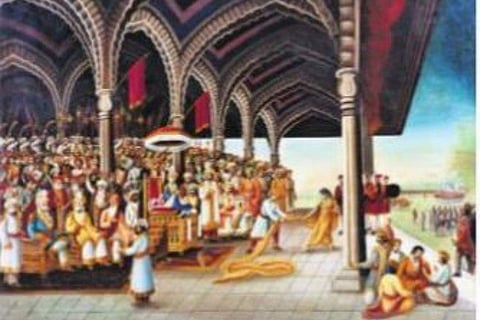
- LIFESTYLE
- FASHION
- FOOD
- ENTERTAINMENT
- EVENTS
- CULTURE
- VIDEOS
- WEB STORIES
- GALLERIES
- GADGETS
- CAR & BIKE
- SOCIETY
- TRAVEL
- NORTH EAST
- INDULGE CONNECT

Sometime in the early 19th century, patuas or scroll artists from Midnapore in West Bengal made their way to the bustling metropolis of then-Calcutta. They settled near the Kalighat temple— the primary tourist attraction. Patuas were known for their narrative-style scroll painting, each going up to 20 feet. But to sustain, the art had to evolve with the times.
This meant reducing the size of the canvas and making the art more relevant. DAG in Delhi quietly takes you back to this long-forgotten time with its extraordinary exhibition, The Babu and the Bazaar. Comprising 250-odd works of Kalighat pats, reverse paintings on glass, printmaking and early oils, it has been curated by historian and scholar Aditi Nath Sarkar.
The DAG’s collection of Kalighat pats is probably the largest after London’s Victoria and Albert Museum with its remarkable group of 645 watercolour drawings and paintings. The works were all made in a span of 100 years, between the 19th and 20th centuries. This was the time when many Europeans were visiting Calcutta—an important trading centre—and would look for mementoes to carry back home.
There were also devotees thronging the temple who wanted cheap religious souvenirs. The patuas had the answer. “They used primary colours and mill-made paper from Britain available in Calcutta. Their canvas had one or two figures and minimal or no background. Made on A4- or postcard-sized paper, these works came to be known as Kalighat pat paintings.
Deities and mythology became a common theme—the Mother Goddess, Shiva, and scenes from the epics,” says Dr Giles Tillotson, Senior VP, Exhibitions, at DAG. As the patuas increasingly settled into city life, what they observed around them made its way onto the canvas. Hence, the portrayal of the so-called ‘babu culture’.
The babus were the elite class, despised by the common masses for their affected airs, hypocritical ways and Westernised lifestyle. The layman began lampooning them in his art, at the same time also painting a picture of society at large. So one had drawings of the well-dressed babus in dhotis and kurtas, sometimes with capes and headdresses visiting prostitutes, who are symbolically dressed in a widow’s white to stress how many women were pushed into prostitution to sustain themselves once they were thrown out of their homes when their husbands died.
Then there are images of women dressing up for their lovers with rose or betel leaf in hand, or playing an instrument. Pets also made it to the canvas, with an image of a cat with a stolen fish in its mouth. “One important factor is that this kind of art has a use: it is at once news and storytelling,” says Sarkar. What is unique about this exhibition is that it also brings to the fore other kinds of art that were being commissioned or created during the Kalighat pat painting period. So you have reverse paintings on glass.
“We must remember that Calcutta at that time was major port doing business with the Cantonese, who had started arriving in the city. They realised how the Kalighat pat was in vogue. To cash in and also to add their own touch of uniqueness, they started with the reverse glass painting. The iconography is, of course, entirely different,” says Tillotson.
Though painted in the pat style, the works have some variations—the facial features are not Indian, the dresses are far from the ones worn in Calcutta and there is often a mountain as a backdrop. There are also larger works in oil, which remind one of the Mughal or Rajasthani miniatures. For example, one painting of Krishna with his gopis, has the gopis dressed in ghagra-cholis, with a distinctive Rajasthani style. There is also a painting of Draupadi’s vastraharan, which is inspired by the Mysore royal painting style. Some of these works were probably commissioned by Gujarati and Marwari business families living in Calcutta